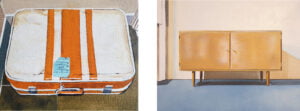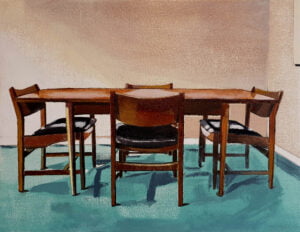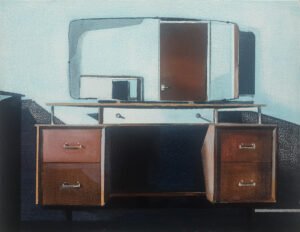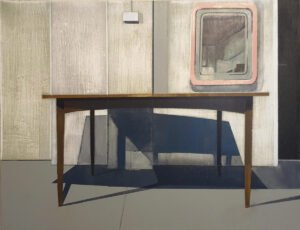Richard Baker is a painter who has exhibited in venues across the world including The Royal Academy of Arts – London, Leeds Art Gallery, The San Francisco Art Institute, National Museum of Poland and galleries across China. He has won a flurry of awards in recent years including the Wells Art Contemporary Patron’s Prize in 2020 and in 2019 he was awarded The Hix Award, was runner up for the London Contemporary Art Prize, and shortlisted for the Neo Art Prize. He is represented by Saul Hay Gallery in Manchester.
Court Spencer caught up with him in his studio in Leeds.

Suitcase, oil on calico over panel, 11.5cm x 14.5cm, 2020 and Sideboard, oil on calico over panel, 24cm x 31cm, 2020. Credit: Richard Baker.
Court: Thank you so much for letting me snoop through your studio. Do you want to start by telling us a little about your practice? Have you always been a painter?
Richard: Currently, my practice is focused on making small scale oil paintings depicting mid-century furniture and other seemingly insignificant objects as an investigation into their hidden human histories. I like to think these objects bore witness to sensuous activity, be it remembered, lived, forgotten, or mythologised. And I present them in a way where they’re dislocated from their conventional domestic settings and isolated within an intangible space. They appear as unadorned formal arrangements in a painterly restaging of the interrelationship of material, image, object and time.
I haven’t always been a painter. I came to painting relatively late in life. I was 28 when I started to paint whilst undertaking a Foundation Course in Art and Design at Hull College. I had always had a love of images but had never known what to do with that until I became interested in painting. Photography always seemed too technical to me, and painting offered a much more organic way of working.

Richard’s studio. Credit: Court Spencer.
Court: The scale of your work feels relatively contained and I know you’ve said in the past that your approach to painting is in bursts of 20 minute blocks so you prefer having your studio space at home so you can dip in and out. Therefore, do you think your approach impacts on the scale of work you make?
Richard: The scale is impacted by several factors, some pragmatic and some philosophical. My studio is relatively small, and I see little point in fighting against that by trying to make works that are too large for the space – life is difficult enough! And so I work to the constraints of my environment. I’ve established that a metre in any direction is about the biggest I can comfortably work on in that space. Other pragmatic factors include transportation and storage of work, both of which can be very problematic if you choose to work on a large scale.
Also, it is philosophically unnecessary to work large in contemporary painting – it’s not the 1950s and I have no desire to envelop the viewer in some grand spiritual experience. Philosophically, I much prefer the works to be quiet and unassuming, the modesty of scale suits that purpose. I think it conveys a jewel like quality, there is something very special, I think, about small objects.

Meeting 2, oil on calico over panel, 24cm x 31cm, 2020. Credit: Richard Baker.
Court: Your subject matter is always really striking. Years ago when I first saw your work you were focusing on chairs. I think you had said they were chairs that you liked though figured you couldn’t afford so this was a way of having them to some extent. Do you work from photos? How do you choose your subject matter? And do you work in series?
Richard: Yes, I work from found photos, usually from sales websites like eBay. The subject matter is chosen from my own interest in furniture design, specifically modernist furniture design from the Bauhaus designs in the 1920s to the Scandinavian designs of the 1950s and 1960s. The clean lines and minimalist designs represent the formal order I strive to achieve through painting. They also serve to imbue the work with a nonlinear relationship with time. The paintings are contemporary, but the depicted objects aren’t, even though the photographs of them are. So it causes a sort of disruption to time. Though, the subject isn’t chosen as a singular aspect of the work, the found photographs are chosen for a combination of object, composition, and colour palette.
I’m not sure that I deliberately work in series but, I think you can view all my works as being part of a series. They all discuss similar concerns, are compositionally similar and are recognisable as being connected to one another. That isn’t to say that the work doesn’t change, it slowly progresses and shifts focus, but it does so within a restricted framework.
Court: Yeah I can see your work is almost one ever evolving series. So what have you got on the go at the moment?
Richard: I’m working on about ten new paintings in a similar vein to the others. My method of working is so slow that I have to work on several at once otherwise I’d never get anything done. They get to a point where they need to be left to dry before applying more paint layers, so while one is drying, I can be working on another, and so on. This way of working also allows for the paintings to inform each other in different ways; a colour mixed for one might turn out to be the perfect colour for another, or a method of application on one could resolve a problem in another.
Court: What has been your career highlight to date?
Richard: I’d have to say there have been two and I don’t think I could choose between them. They’ve both been incredibly important but for slightly different reasons.
Winning the Hix Award in 2019 is obviously a highlight. Winning any award gives a much needed sense of validation. I have been entering open competitions for twenty years. My goal in doing so has always been to just get my work in exhibitions and gain exposure, which has worked well, but I never expected to actually win an award. My work is small and quiet and can easily be overlooked. Awards tend to go to the big, bright, shiny things so I was pleasantly surprised to win the Hix. The prize money allowed me to turn my practice into a profession and spend all my time painting, which has always been the goal. It has also acquainted me with a lot of industry professionals.
The other highlight was having my work in The John Moore’s exhibition in 2018 which, for most painters, is the Holy Grail of exhibitions and is widely regarded as the most important exhibition of contemporary painting in the UK. Having work in the John Moore’s has been an ambition for over 20 years and one that I never thought would be realised. The opening events and a weekend of fun in Liverpool are a time I will cherish forever. I met some truly wonderful artists and other people who will remain friends for life. It was a magnificent experience.

Dressing Table, oil on calico over panel, 24cm x 31cm, 2021. Credit: Richard Baker.
Court: You’ve been winning quite a few awards lately, and you mentioned you’ve been applying for awards for about 20 years. What’s your take on these sorts of awards?
Richard: For me it was always more about being selected for the exhibitions to get my work seen by a large audience. People have differing views on open competitions and exhibitions. Some people resent the idea of competition and the entry fees. However, in my opinion, the entry fees are not exorbitant, and the exhibitions provide a fantastic opportunity to exhibit in different cities and get your work seen by a lot of people including gallerists, collectors, journalists, and other artists. Perhaps an entry fee will be £25 but if your work is selected it will be shown in a gallery in London, or other major city, with all the promotion and marketing clout that comes with that and all you have to do is turn up at the opening and talk to people. As with the John Moore’s, I have met some lifelong friends and colleagues at those opening events and have gone on to work with them and exhibit with them in addition to the original exhibition we were selected for.
They also provide a much-needed framework in what can be the quite tenuous and ambiguous calendar of a self-employed artist. I enter about twenty a year and they provide me with useful deadlines which give me a point of focus. They are an aspiration, provide a goal to work towards, and force me to remain busy and continue to push myself.
Court: You’ve also been selling a bit through the Artist Support Pledge and using online auction sites. Do you feel lockdown has had a positive impact on sales for you?
Richard: I’m not sure how much of it has been driven by lockdown and how much is the Artist Support Pledge itself, although, the pledge was born out of lockdown. It’s a great, inclusive model for selling work and has certainly been a life saver. It has also enabled me to buy work by other artists. In other ways though I think that lockdown has had a detrimental effect on sales as some people are hesitant to buy paintings online and prefer to see them in real life before buying.
Court: How did the lockdown experience impact your motivation and practice?
Richard: Everyone has reacted differently, and I know that for some people it has enabled them to create lots and lots of work. For me, it has had the opposite effect. I’ve found it very difficult to remain motivated without the physical aspects of life. Painting is a very physical thing and without showing work in real life exhibitions or having any other of the social aspects of life going on, I have found it very difficult to find a reason to make work. I was discussing this recently with my friend and fellow painter, Dr Tom Palin, and I think he summed up the situation perfectly for me when he said: “life needs to happen in order for painting to happen.”

Dining Table with Mirror, oil on calico, 46cm x 60cm, 2019. Credit: Richard Baker.
Court: So with it feeling like aspects of life are beginning to happen again, are there any projects you’ve always wanted to take on?
Richard: Yes, I would really like to work on, and put together, a solo exhibition. A solo exhibition at the Hix Gallery had been planned as part of the award prize, so in my head I was working towards that. But the gallery closed due to lockdown and the exhibition was cancelled. So, for me that remains a missing piece of the puzzle so to speak. Something that feels like it should have already happened but hasn’t. As things begin to open up again, I’ll start to approach other galleries for that.
Court: I know you have plans to open a Foyer Gallery at your house. Can you tell us a bit about that?
Richard: It’s really an idea that stemmed from the Artist Support Pledge. I was suddenly able to acquire a lot of paintings. I had them all hanging in my hallway and staircase, and it just seemed like a natural progression to open the space as a gallery. I’ve always worked with other people to put on exhibitions in spaces around Leeds and I have a lot of experience in curation and exhibition management to draw on, so I’m starting from a good position. I had planned to open in January, but lockdown stopped that from happening. I am now hoping to be able to open in July so watch this space.
Court: Yeah I had wanted to start putting on exhibitions from my flat, I put a hanging system in but then ended up moving! I did some research earlier this year looking at what support artists felt they needed to develop their careers and one of the things that most said was more opportunities to exhibit. So I think the more spaces we have to show work, the better! Do you have any upcoming exhibitions that we can keep an eye out for this year?
Richard: I currently have some work at the Hyde Park Book Club in an exhibition called Crysalis which has been put on by Hyde Park Art Club and I’ve just had work selected for the Leeds Summer Group Show. I’ve also submitted for the Wells Art Contemporary again this year, but I am still waiting to hear if I have been selected.
Court: Good luck with the Wells, I hope you’re selected. And thank you so much for your time. It really was fab to see your studio and hear more about your work and your process.
Filed under: Art & Photography
Tagged with: art and photography, artist support pledge, column, domestic, drawing, hix award, interview, leeds, oil painting, painting



Comments